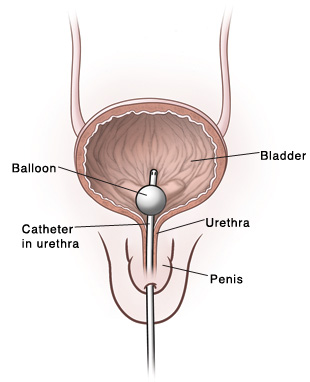When Your Child Needs a Foley Catheter (Boy)
 |
| A balloon is filled with water to hold the catheter in place inside the bladder. |
A Foley catheter (also called an indwelling catheter) is a soft, thin, flexible tube placed into the bladder to drain urine. Placing the catheter can be done in an operating room, exam room, or hospital room. You may be allowed to stay with your child during the placement.
Gender words are used here to talk about anatomy and health risk. Please use this information in a way that works best for you and your provider as you talk about your care.
Why is a Foley catheter needed?
Urine is liquid waste that the kidneys make. Urine flows from the kidneys into the bladder to be stored. The bladder is located in the lower belly (abdomen). The urethra carries urine from the bladder through the penis out of the body. A Foley catheter may be needed if:
-
Your child can’t get up and use the toilet because of an injury, surgery, or illness.
-
Your child is taking medicines that may cause them to have trouble emptying their bladder.
-
A healthcare provider needs to measure the amount of urine your child passes.
How is a Foley catheter placed in your child?
-
Your child lies on their back on an exam table or hospital bed.
-
Your child can have a comfort item, such as a stuffed animal, with them if the procedure is done in an exam room or a hospital room.
-
If you’re present during the procedure, you can help by holding your child’s hand or distracting them.
-
The healthcare provider washes their hands and puts on sterile gloves.
-
The catheter is prepared for insertion. One end of the catheter has a balloon. The other end has 2 ports. One port is used to inflate the balloon with water. The other port is connected to a bag that collects urine.
-
A sterile sheet is used to cover the lower part of your child’s body.
-
Lubricating jelly is applied to the end of the catheter that has the balloon. This is so that the catheter can slide through the urethra easily.
-
The healthcare provider gently holds your child’s penis. This may be uncomfortable for your child. But it’s very important for your child to stay still.
-
The urethra opening is cleansed.
-
The healthcare provider gently inserts the catheter into your child's urethra until it reaches his bladder.
-
The healthcare provider inserts water into the catheter to inflate the balloon. The balloon keeps the catheter in place in the bladder. The pressure from the balloon may cause your child to feel as though they need to pass urine. This feeling lasts only a short time.
-
When the catheter is in place, urine flows out of the bladder and drains into a bag. The bag often hangs from the side of the bed.
-
Nursing staff will empty your child’s urine bag regularly. The healthcare provider removes the catheter when it is no longer needed.
How to help your child get ready
If you know that your child will need a Foley catheter during a hospital stay, you can help them to get ready in advance. How you do this depends on your child’s needs.
-
Explain what will happen during the procedure in short and simple terms.
-
Make sure your child understands that the healthcare provider will be touching your child’s private area. Reassure your child that this is part of the procedure.
-
The procedure may cause some mild pain. But the catheter won’t hurt once it’s in place.
-
Your child may feel nervous or afraid. They may even cry. Let your child know that you’ll be in the room with them or nearby if they need you.
-
Many hospitals have a child life specialist. This person is specially trained to help children understand what to expect during their time in the hospital. Books, videos, dolls, and toys may be used to help explain the procedure to your child. Ask your child’s healthcare provider about the resources available at your child’s hospital.
Risks and possible complications
There is a small chance of infection (urinary tract infection or local infection in the genital area) when a Foley catheter is in place. It’s important to keep the catheter site as clean as possible to prevent infection. Once in a while, the catheter may be linked to irritation or bladder spasms.
Online Medical Reviewer:
Amy Finke RN BSN
Online Medical Reviewer:
Marc Greenstein MD
Online Medical Reviewer:
Raymond Kent Turley BSN MSN RN
Date Last Reviewed:
6/1/2022
© 2000-2024 The StayWell Company, LLC. All rights reserved. This information is not intended as a substitute for professional medical care. Always follow your healthcare professional's instructions.